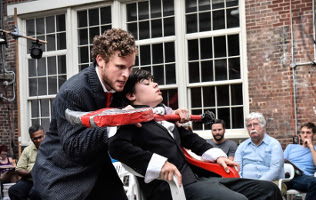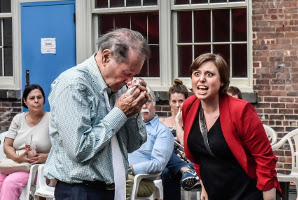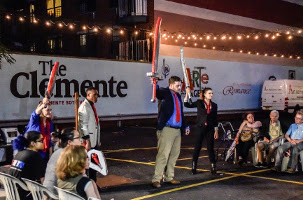
Beate Hein Bennett
|
WHAT
GOES UP MUST COME DOWN
July 27 - Aug 12 There is no playwright that has dramatically dissected and theatrically plumbed the vagaries of power, the usurpation of power and the tragic consequences of these machinations like William Shakespeare. His History Plays, based on the Holinshed Chronicles, lay bare the skeletal reality of the medieval Wheel of Fortune that emblematically depicts the rise and fall of kings. For his trilogy about Henry VI, Shakespeare deals with the most troublesome period of English royal succession, namely the feud between the Lancaster and the Plantagenet/York clans as to which is the rightful dynasty to inherit and wear the English crown.
The feud, known as the War of Roses because of the white rose (Plantagenet) and red rose (Lancaster) adopted as insignia by the feuding clans, originated in the forced abdication of Richard II and his yielding his scepter to Henry Bolingbroke, Duke of Lancaster, whom he declared his heir and who ascended the throne as Henry IV. The culmination of this bloody period was the usurpation of Richard of Gloucester, which Shakespeare dramatized in “Richard III,” perhaps his most gruesome play, whose central villainous hero has his scheming and murder apprenticeship in “Henry VI, Part 3.” The Henry VI trilogy belongs to Shakespeare’s earliest plays, replete with on-stage battle scenes, gruesome murders, and beheadings—probably beloved by the Elizabethan audiences. Part 3 is relatively short but it contains some scenes that are striking for their profound humanity in showing the private tragedy in midst of a battle; in one scene two warriors drag each a body on stage; each proceeds to rob “his” corpse while mocking the dead. However, as each removes the visor from the dead man’s face, one recognizes that he has killed his father, while the other recognizes that he has killed his own son. To the side of this scene sits King Henry who watches this tragedy unfold; just a moment earlier he had ruminated about the futility of this war and the peace and contentment of a shepherd’s life compared to that of a king who must fear his “subjects’ treachery.”
Shakespeare in the parking lot? And why not? After all, fifty some years ago Joseph Papp started out on the Lower Eastside in an open space near the FDR. The Drilling Company has been doing this for years. The audience obviously enjoys an evening watching and listening to a young company launch itself onto and into some wooly Shakespearian battleground. Hamilton Clancy directs a committed group of actors who delight in playing this royal agon like a fast basketball game on an asphalt court in the twilight hours with city noises hovering around. The space is several contiguous parking spaces; the audience sits alongside the traverse stage space that is bordered on one end by a low riser with a set of orange plastic chairs and on the other by a curtain that blocks a backstage area. In the center is a small dais with The Throne, a plastic chair, painted half in red and half in white, a red plastic bucket on one side and a white plastic bucket on the other. The play starts out with a skirmish between the two factions— in The Parliament House in London—and with horrendous war hoops and raised handmade supersize surreal toy-like medieval weapons, such as lances, swords, axes, ball-and-chain the two teams rush each other.
The Whites roust the Reds and the Earl of Warwick, played with authority by Kyle Maxwell, plants old Richard, Duke of York, on the throne. Bill Green, a mature actor, plays Old York with the dignity and subtlety that Shakespeare had bestowed on him in the critical debate with the much younger King Henry VI over who should be the rightful ruler over England. In this first scene, Old York’s sons already establish their distinct characters: the oldest is Edward, eventually crowned King Edward IV, played by Lee Seymour with conniving and deceptive charm; next is Richard Gloucester (the misshapen “nihilist”), played by Alessandro Colla with clever cunning and virile energy; the third son, George Clarence, is played by Eddie Shields with mercurial, sly deference to his older brothers. Skyler Gallun gives Henry VI a melancholy elegance and a certain frailty as he tries to avoid civil war while insisting on his rightful claim to the throne as the grandson to Henry IV and son to Henry V who had conquered France. However, kingmaker Warwick, in his endeavor to keep Old Richard of York on the throne, bluntly points out, that most of France was lost by Henry VI. The competing kingmaker and raisonneur on behalf of Henry VI is Lord Clifford, played with brutal ferocity by Bradford B. Frost; later in the production, he enacts also French King Louis, Hastings, and Keeper #1.
One other interesting character is the ferocious Queen Margaret, wife to Henry VI who defends his royal prerogative like an Amazon, meddling in all states of affairs from battlefield to state diplomacy. She sends Henry from the battlefield by declaring him a hindrance, and so he willingly withdraws and contemplates the spurious life of kings versus the happy life of shepherds. Evangeline Fontaine as Queen Margaret musters all the force of a virago and spits her vituperative lines in whatever direction is warranted. The rest of the ensemble includes: Joseph Edward Clancy who plays young Rutland and (after his ignominious murder) a Messenger; Erin Noll as Henry’s son Prince Edward; Bryce Dutton as Somerset and the Warrior-Son; Kendra Lee Oberhauser as the Widow Lady Grey, the unwilling object of King Edward’s lust who becomes his Queen Elizabeth at the end; and Gracie Winchester who plays the Duke of Norfolk on York’s side, as well as Lady Bona, sister to King Louis of France, undiplomatically jilted by King Edward; Marcus Jones as Old York’s brother Montague; Ben Peterson as Exeter; Una Clancy, Lindsay Nance, Sophie Sorenson, Ross Stoner play assorted nobles and war victims. All play with energetic commitment and obvious delight in speaking Shakespeare’s lusty lines. This is important when playing in the uncontrollable environment of a parking lot. However, I would enjoin young actors to study and appreciate Shakespeare’s rich rhetorical rhythms and devices which inform not only the comprehensibility but, more importantly, the meanings of the lines. It takes a great amount of technique to sustain the requisite articulation in order for those “immortal words” not to die on the way to the spectators’ ears and understanding.
All in all, I enjoyed this, rarely performed, freewheeling Shakespeare in modern clothes; however, I am not sure if the director Hamilton Clancy accomplished his intent to parallel the action of this play with contemporary American politics, albeit the prevailing political chaos can certainly be extrapolated in general from the dramatic situation. His program note sets the production in “Place: USA” and “Time: Maybe soon.” Furthermore, he made casting choices that are “gender blind and age-blind to reflect some of the variety in our political landscape.” And, very New York conscious, he points out that “streets on the Lower East Side are already named after these characters,” i.e. the streets in the vicinity, Essex, Suffolk, and Norfolk, the site of the Clemente Soto Velez Cultural and Educational Center parking lot where the production takes place. |
| museums | NYTW mail | recordings | coupons | publications | classified |





